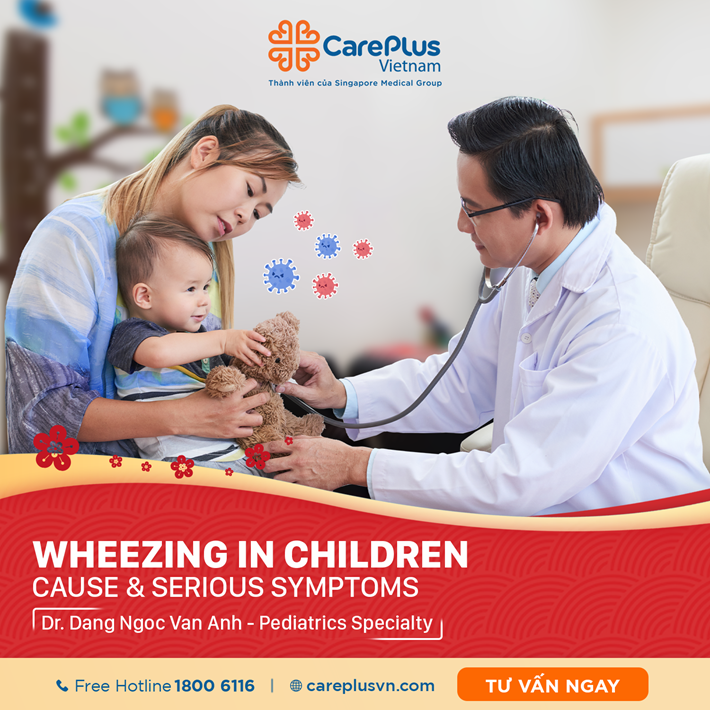WHEEZING IN CHILDREN: CAUSE & SERIOUS SYMPTOM
Wheezing is a relatively high-pitched whistling noise produced by movement of air through narrowed or compressed small airways. It is common in the first few years of life and is typically caused by viral respiratory tract infection or asthma, but other possible causes include inhaled irritants or allergens, esophageal reflux, and heart failure.

2/2/2024 1:10:39 PM
What is wheezing?
Wheezing is a common condition in children under 2-3 years old because at this age the bronchi are still small and very easy to constrict, swell, and secrete fluid when infected.
For newborns, it is necessary to distinguish wheezing from nasal congestion. Because newborns breathe mainly through their nose, while the size of their nostrils is small and very easy to get blocked when they have a cold, making them breathe hard. At this time, you can clear the baby's nose with 2-3 drops of saline, then listen again. The baby with a stuffy nose will breathe more smoothly after clearing the nose.
Cause & Symptom
Wheezing is often accompanied by recurrent dry or productive cough. Other symptoms depend on the etiology and may include fever, runny nose (viral infection), and feeding difficulties (eg, due to heart failure or dysphagia).
On examination, wheezing manifests mainly on expiration, unless airway narrowing is severe, in which case wheezing can be heard on inspiration. Other findings present with more severe illness may include tachypnea, nasal flaring, intercostal and/or lymphoid retractions, and cyanosis. Children with respiratory infection may have fever.
Acute wheezing (a few hours to a few days):
• Asthma
• Infection: The most common cause of acute wheezing in children under two years old is bronchitis caused by a virus, usually due to respiratory syntactical virus (RSV) infection
• Foreign body airway: Suspected in any patient who has sudden onset of wheezing, even if there is no clear history of choking. Should be suspected in patients with wheezing on one side or uneven breathing sounds. In children, unlike adults, foreign bodies can get stuck in any bronchus without favoring the right side. Patients may also present with chronic symptoms of prolonged coughing if not detected early.
Chronic or recurrent wheezing
Differential diagnosis of chronic or episodic wheezing includes:
-
Abnormalities of the structure of the bronchial tree or other thoracic structures such as: laryngeal cartilage softening, vascular ring compression, stenosis / tracheal membrane, cyst, tumor, thymus gland compression.
-
Structural abnormalities, including malformations of the bronchial tree and vascular ring compression, are one of the most common causes of persistent wheezing that appears early in life (usually within the first few months after birth) and does not respond to asthma treatment
The causes of functional abnormalities of chronic wheezing include asthma, recurrent aspiration syndrome, gastroesophageal reflux, bronchopulmonary dysplasia, ciliary dyskinesia, and interstitial lung disease.
What to do when children wheeze
Wheezing is an abnormal breathing sound, so you need to take your child to a pediatrician for examination to determine the cause and appropriate treatment.
Children need to be hospitalized when wheezing
• Have signs of respiratory failure
• Wheezing starts suddenly and acutely, suspecting a foreign body in the airway
• Wheezing recurs or is chronic, need to find the cause
• Wheezing occurs in children < 3 months
Do not arbitrarily use antibiotics, anti-inflammatory, expectorant drugs because they may not be effective for children and may make them wheeze more and worse.